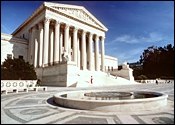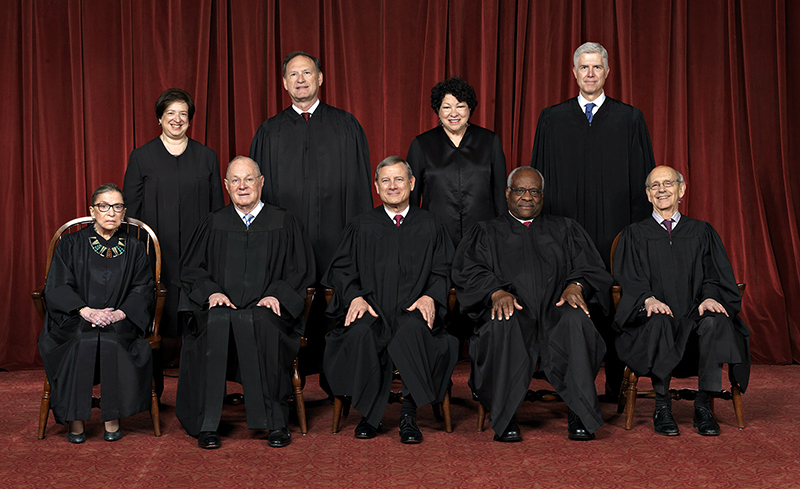U.S. Court System

The U.S. Supreme Court
Building in Washington D. C.
Diagram of the U.S. Court System

- U.S. Supreme Court
- Federal Courts of Appeal
- Federal District Courts
- State Courts
- Court of Claims
- Court of Military Appeals
- Court of International Trade
The
U.S. Supreme Court
The
Supreme Court of the United States was created by Sec.
1 Article III of the Constitution. Its jurisdiction is set out by statute
in Title 28 of the
U.S. Code. The organization
of the Court is also spelled out by legislation. The Court itself develops the rules governing
the presentation of cases. One of the most
important powers of the Supreme Court is judicial
review. While the Supreme Court is a separate branch of government, outside
factors do exert some influence on the
Court.
U.S. Supreme Court Justices

There are nine justices; a Chief Justice of the United States and eight
associate justices, who are appointed by the president with the advice and
consent of the Senate. Justices serve during good behavior (usually until
death, retirement or resignation.)
|
Chief Justice |
Year Appointed |
President |
|
2005(CJ) |
Bush(CJ) |
|
|
Associate Justices |
Year Appointed |
President |
|
1988 |
Reagan |
|
|
1991 |
George H.W. Bush |
|
|
1993 |
Clinton |
|
|
1994 |
Clinton |
|
|
2006 |
G.W.Bush |
|
|
2009 |
Obama |
|
|
2010 |
Obama |
|
|
2017 |
Trump |
The 11 U.S. presidents since World War II have appointed 28 Supreme Court members. Republicans 17, Democrats 11.
|
President Donald
J. Trump |
Party Republican |
Appointments 1 |
Judicial
Review
Judicial review consists of:
-The power of the courts to declare laws invalid if they violate the Constitution.
-The supremacy of federal laws or treaties when they differ from state and local laws.
-The role of the Court as the final authority on the meaning of the Constitution.
Influences
on the Court
There
exist both legal and political influences on the Supreme Court justices and
their decisions.
Among the legal influences on Supreme Court decisions are:
-The Constraints of the Facts: Courts cannot make a ruling unless they have an actual case brought before it. The facts of a case are the relevant circumstances of a legal dispute or offense. The Supreme Court must respond to the facts of a dispute.
-The Constraints of the Law: Among the legal constraints in deciding cases, the Supreme Court must determine which laws are relevant. These include; interpretation of the Constitution, interpretation of statutes, and interpretation of precedent.
Among the political influences on Supreme Court Decisions are:
-"Outside Influences" Such as the force of public opinion, pressure from interest groups, and the leverage of public officials.
-"Inside Influences" Such as justices' personal beliefs, political attitudes, and the relationship between justices.
How
Cases Make Their Way to the U.S. Supreme Court
Each
year, about 4,500 cases are requested for review by the Supreme Court. Less
than 200 cases are actually decided by the Court each year.
There are three ways for a case to make its way to the US Supreme Court.
1) There are cases in which the US Supreme Court has original jurisdiction
(heard there first). Cases in which a state is a party and cases dealing with
diplomatic personnel, like ambassadors, are the two examples.
2) Those cases appealed from lower federal courts can be heard at the Supreme Court. Some laws obligate (or force) the Supreme Court to hear them. But most come up for review on the writ of certiorari, a discretionary writ that the court grants or refuses at its own discretion. The writ is granted if four of the justices want it to be heard.
3) The US Supreme Court reviews appeals from state supreme courts that present substantial "federal questions," usually where a constitutional right has been denied in the state courts.
In both civil and criminal law, the Supreme Court is the final court of appeal.
State
Courts
-Each
state
has a court system that exist independently from the
federal courts. State court systems have trial courts at the bottom level and
appellate courts at the top. Over 95% of the nation's legal cases are decided
in state courts (or local courts, which are agents of the states).
-Some states have two appellate levels, and others have only a single appellate court. States vary in the way they organize and name their courts, but they usually give some lower courts specialized titles and jurisdictions. Family courts settle such issues as divorce and child-custody disputes, and probate courts handle the settlement of the estates of deceased persons. Below these specialized trial courts are less formal trial courts, such as magistrate courts and justice of the peace courts. These handle a variety of minor cases, such as traffic offenses, and usually do not use a jury.
-Cases that originate in state courts can be appealed to a federal court if a federal issue is involved and usually only after all avenues of appeal in the state courts have been tried.
-In 1990 there were over 88 million cases heard at the state trial courts throughout the U.S. One hundred and sixty seven thousand cases were appealed at the next level, while sixty two thousand made it to the state courts of last resort.
Federal
Courts of Appeal
When
cases are appealed from district courts, they go to a federal court of appeals.
Courts of appeals do not use juries or witnesses. No new evidence is submitted
in an appealed case; appellate courts base their decisions on a review of
lower-court records. In 1990, the 158 judges handled about 41,000 cases.
There are 12 general appeals courts. All but one of them (which serves only the District of Columbia) serve an area consisting of three to nine states (called a circuit.) There is also the U.S. Court of Appeals for the Federal Circuit, which specializes in appeals of decisions in cases involving patents, contract claims against the federal government, federal employment cases and international trade.
Go see recent Federal Courts of Appeal decisions.
Between four and twenty six judges sit on each court of appeals, and each case is usually heard by a panel of three judges. Courts of appeals offer the best hope of reversal for many appellants, since the Supreme Court hears so few cases. Fewer than 1 percent of the cases heard by federal appeals courts are later reviewed by the Supreme Court.
Federal
District Courts
All
federal courts, except for the U.S. Supreme Court were created by Congress.
There are ninety four federal district courts across the country, with at least
one in every state (larger states have up to four). There are about 550 federal
district-court judges who are appointed by the president with the advice of the
Senate. District courts are the only courts in the federal system in which
juries hear testimony in some cases, and most cases at this level are presented
before a single judge. They heard about 267,000 cases in 1990. Federal district
courts are bound by legal precedents established by the Supreme Court. Most
federal cases end with the district court's decision.
Court
of Military Appeals
The
Court of Military Appeals hears appeals of military court-martial (when a
person who is in the military commits a crime they can be tried and punished by
the military courts.)
Court
of International Trade
The
Court of International Trade hears cases involving appeals of rulings of U.S.
Customs offices.
Court
of Claims
The
Court of Claims hears cases in which the U.S. Government is
sued.